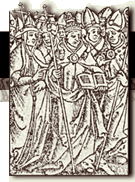

 |
 |
|||
|
|
||||
Liturgical Year as Organization of
|
||||
|
The calendrical organization of the liturgical
year becomes concrete in the organization of liturgical books, whose
texts are typically arranged in this order:
The common of saints is the section of a liturgical book that contains
services (whether a mass or an office) for those saints who do not have
full proper services, "proper" meaning services particular to
a specific liturgical occasion. The common of saints offers texts that
are applicable to any saint in one of several categories: one apostle,
many apostles, one martyr, many martyrs, one confessor (one whose life
"confessed" or attested to his extraordinary love of God, but
who did not die for the sake of that love), many confessors, one virgin,
many virgins. The common elements of the service may be completed by proper
prayers contained in the sanctorale.
Clearly, the arrangement of books for the mass and books for the office
is parallel in five large sections (calendar, temporale, sanctorale, common
of saints, services addressing the "vota" or concerns of particular
persons or moments). The difference lies in the location of the ordinary
or core text, the one that is recited at every occurrence of the service:
for the Mass, it is the body of material around the Canon and that is
usually placed in the middle of the book. For the Office, the ordinary
or common text is the psalter with its accompanying materials, and it
is frequently placed at the beginning of the book. It should be pointed
out, however, that in the manuscripts the text sections of the Office
display some considerable variation in their order. Dispersal throughout
the book of the pieces of text necessary for any one given service is
a corollary of the concepts of common
and proper texts. |
||||||||||